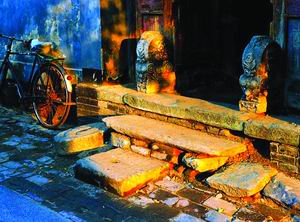
They see themselves as warriors in a desperate battle to
preserve old Beijing.
After arranging to meet online, about 20 people gathered at exit
B of the Qianmen metro station one recent Sunday morning,
exchanging stories and talking about the photos they were going to
take.
The "warriors" are fans of hutong architecture and art, and
Dazhalan a famous concentration of small lanes which once filled
Beijing, in the Qianmen area of the capital is one of their
favorite areas.
The targets of their cameras are ancient gates, courtyards,
roofs and any detailed sculptures or paintings.
These pictures aren't intended for a photography contest, but
rather a race against time to create a visual record of a piece of
fading history.
They plan to collect their images in an online hutong
museum.
According to media reports, the number of registered hutong in
Beijing has shrunk from 3,600 in 1980 to about 1,200 today. And the
number is still falling.
A government circular issued at the end of last year, the
largest of its kind in terms of affected areas and number of
people, said more hutong would be removed, news that stung
supporters of hutong culture.
The announcement motivated Zhang Jinqi, the leader of the hutong
"warriors," to begin compiling a photographic record.
Zhang grew up in Dazhalan, a 1.26-square-kilometre area of 114
streets and alleys. With more than 51,000 residents, it claims to
be one of the most densely-populated residential communities in the
world.
Hutong life nourished Zhang from his childhood, he said,
explaining his passion for the tiny alleys.
"I still clearly remember the peaceful and harmonious
residential surroundings in which people developed mutual
understanding and close ties," he said.
"There was a 70-year-old granny, who was very kind and helped
bring up neighbours' kids, guarded their doors and filled the coal
stoves for each family while they were out working."
Memories like these are a reminder of the urgency to preserve
the hutong, Zhang said.
But for some, the significance of Dazhalan's existence makes it
worth more than a simple hutong protection campaign. In the Qing
Dynasty (1644-1911), it was a prosperous commercial district
neighboring the Imperial Palace (The Forbidden City).
As the gathering place for banks, theatres, high-end
entertainment lounges and dozens of century-old shops, Dazhalan
witnessed the ups and downs of China's economic development and its
people's lives for centuries.
That's why Zhang will never forget the painful memory about six
years ago when he returned to Yanjia hutong in Dazhalan. "It was
buried by bulldozers," he said.
Learning that the number of hutong in Beijing had decreased
dramatically, Zhang quit his job as a copy editor in 2000 and
devoted himself to preserving them and hunting for old photos.
He said that last year he took 40,000 photos capturing the
hutong scenes in Dazhalan.
Now, Zhang takes pictures on Monday, Wednesday and Friday, and
develops the film and classifies the photos on Tuesday and
Thursday. That's his entire life.
Fortunately, Zhang is not alone in his passion.
Volunteer photographers and people of all ages from all walks of
life have been attracted by fascinating tales of the hutong, while
others just want to help out.
Xue Yinong, 55, a retired public servant from Changchun, capital
of Northeast China's Jilin Province, joined the team one Sunday on
a mission to find more vivid hutong scenes and stories she had read
about in books and seen on television.
"I've long been eager to visit Beijing's hutong, especially in
Dazhalan area, where the famous eight hutong sit," Xue said.
She learnt about the hutong tour from her son, a netizen who is
attempting to earn his doctorate in software design in Beijing. It
was his invitation that made her travel more than 1,000 kilometres
just to volunteer.
"I never expected that my long-awaited visit to the hutong would
happen this way with a group of strangers, but it seemed as if we
all knew each other even before we met," she said excitedly.
Sense of responsibility
As the spread of the old Beijing buildings lay before her eyes,
Xue was touched by the spirit of the younger generation on the
various teams.
"It's hard to believe there are so many young people who care
that much and do so much research on hutong," she said.
But the photographers aren't shooting just Dazhalan.
Dozens of hutong in the Qianmen area is on the urban renewal
blacklist, which has caused the teams to redouble their
efforts.
"We are racing against time to take as many pictures as we can
to preserve the original look of various hutong," said Zhang Wei,
29, who started the website www.oldbeijing.net, a platform
where the teams gather and arrange their activities.
In his eyes, each house and yard differs from others in
decoration and layout. From these characteristics, Zhang says he
can tell the original resident's family status, ethnicity, and
official rank in the imperial dynasties.
"Hutong in Beijing resemble blood vessels in human beings," he
said. "Without hutong, how can we prove the capital's
3,000-year-old civilized history? The hutong has borne witness to
that history in terms of the development of the city and the
people.
In his eyes, hutong is as famous and attractive as the Summer
Palace, the Great Wall and roast duck. But in comparison, he said,
hutong deserves much more careful research.
"You can easily find out very detailed records and stories of
the Summer Palace, Beihai Park and other royal facilities from
books and documents, but there is no systematic documentation for
hutong," said Zhang.
(China Daily July 4, 2006)

